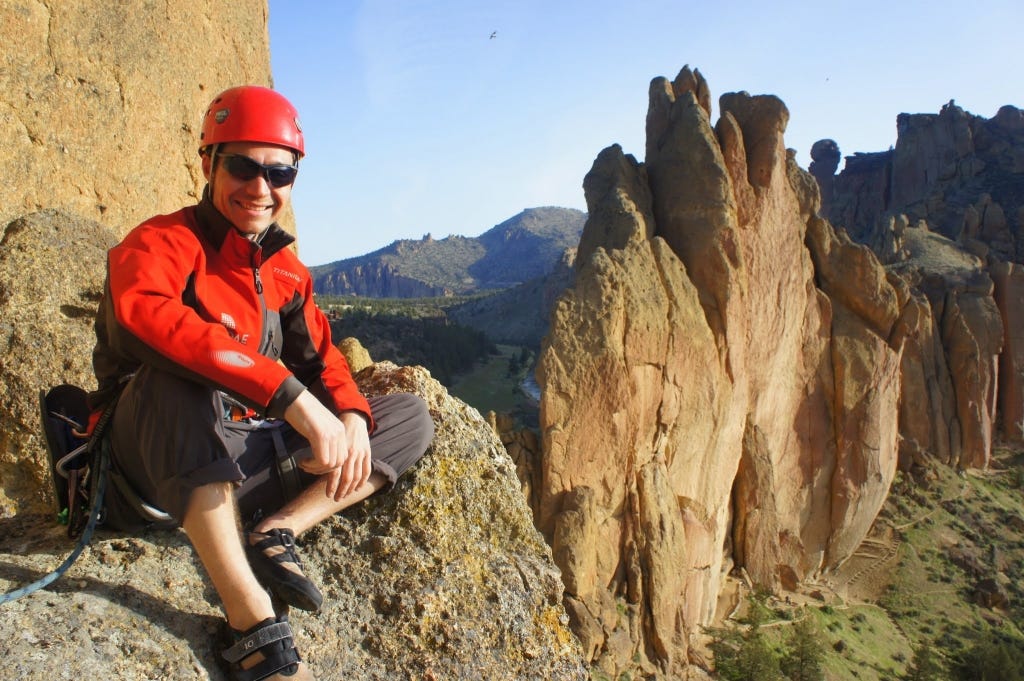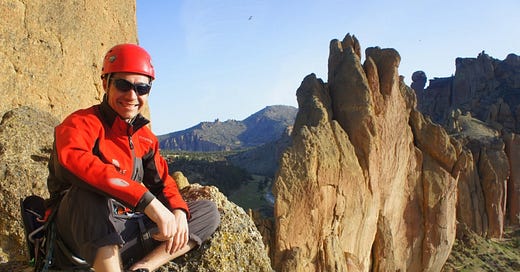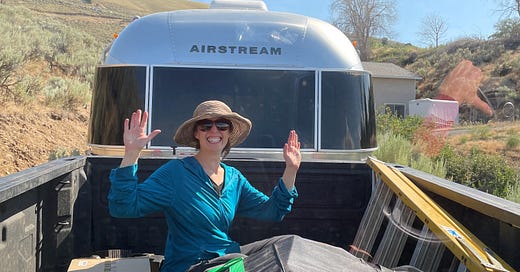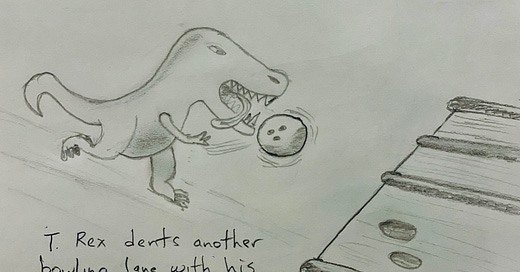
Control Freaks Never Prosper

Sunrise climb at Smith Rock in Central Oregon. There’s a moment of truth in rock climbing and mountain biking where forward progress is the only option. Letting go of a solid climbing hold to make a move, fear swells in your throat until you reach a safer zone and breathe easier. Launching into a treacherous descent on the bike, you grip the handlebars in anticipation, then relax and go with the flow. For me, these are two distinct types of fear, static and dynamic. Rock climbing is the former, an evaluative fear of leaving a position you know in a slow, calculated manner. Slow is good when you're perched high above the ground on tiny footholds, fingers gripping a ledge, forearms filled with blood and thoughts of falling racing through your mind. Overgripping expends more energy and makes you fail faster. On the other end, mountain biking is a dynamic fear where you rip around a corner, suspension jackhammering over rocks. Decision: weave left, right or try to jump the whole damn thing? One split second to decide how to navigate obstacles and then they’re behind you. Both these sports are certainly adrenalin-filled and intense, yet so different. Climbing was my primary sport for 10 years, the thrill of conquering new routes crack in my veins. Chelsea grew to know terms like “redpoint” and “5.12b” like she was a climber herself. I dreamed about routes I’d climbed, retracing each move in my mind before I’d go back and repeat them in person, pushing myself. I loved it, and just writing this makes me smile thinking of climbing High Plains Drifter with my buddy Zack, views of the Columbia Gorge stretching out for miles behind me.

High above Banks Lake in NE Washington on a climb called "Fire Crotch." Because if you slip and fall, it's not good for things... Fear of falling off a route is always present, even as merely a grain of doubt. There are a couple ways to go about it - believing you can’t make a move and giving up, or knowing the consequences and going for it, attempting to latch onto the next hold. Either way, if you fail there is brief moment where you’re in flight before the rope, bolts, quick draws and your climbing partner all work together to stop your fall. They are usually clean and smooth, yet falls are something that can be intimidating. Failure and its byproducts usually are! For a long time, falling was something I would literally practice. Climb above my last protective bolt, let go and take a fall. Repeat. The idea was to disconnect the anticipation of falling and fear rather than dreading slipping off a move. Non-climbers will think I’m crazy, but every single book about mental training for climbing that I’ve ever read recommended this. And it works! You can literally train your mind not to fear the fall, and I was able to push my skills to new levels. The sinking feeling in the pit of my stomach at the start of every fall was never eliminated, but my nerves steeled against it. When Fear Takes Over In early 2012, a switch flipped inside me. I suddenly loathed the idea of falling. Even writing about falling, my palms are sweaty as if I’m approaching a tough section of a climb where I know falling is likely. I stopped dreaming about a successful ascent and dreaded the failure. It was no longer fun, yet I kept going to the gym or heading out to climb outside as part of my programming. “I’m pretty good at this, so I’ll continue.” I still enjoyed the social aspect of the gym and the puzzle-deciphering of climbing, but something was missing. I frankly don’t know why my desire to climb disappeared so quickly. Initially, I thought I was just bored after doing it for a decade. I suspect it was deeper than that though. I think it was continuously pushing boundaries with my business at the time, every decision a difficult one that my success hinged upon. There’s a fear management reservoir in my body and mine was tapped out. There are studies about our ability as humans to only make a certain amount of choices per day, even easy ones, and I think that applies to managing fear as well. Even free-solo climber Alex Honnold, whose abilities to curb fear are famous, ran out of his elixir halfway up free-soloing 2,000’ Half Dome in Yosemite. Watching the (recreated) moment on film, he freezes (2:20 in the film) with his back to the wall, a quarter mile of potential free fall below him, and then summons the courage to continue. Since shelving my climbing rope, I’ve picked up mountain biking as my primary activity. Oddly enough, I’d abstained in past years because I considered it more dangerous than climbing. Something about ripping down a trail into the unknown made it seem more treacherous. Tougher to control my surroundings in a free-flowing trail ride than a static, move-by-move climb. (After wrecking numerous times following skilled friends down rocky trails, I know there is more risk of death with climbing, but more frequent injury with biking.) The learning curve is as steep as the slopes I rode, and bouncing off rocks happened a few times in the first year of riding.

Climbing trip to Lake Louise (Canada). Climber is Dan Suppnick. Ever since I was a little kid, I’ve over-gripped and tried to control my surroundings. Something in me craved routine and order, neither of which were prevalent in my family. (Something I’m grateful for now!) Playing Monopoly with me involved rolling the dice...and that’s all. I’d move the pieces, hand out money and cards and control it all. A small example of a reality resulting in not being vulnerable and truly trusting others to do their part. Self-sufficient and in control, always. Running the show solo has absolutely helped me with whatever successes I’ve achieved, yet the expression “your best is also your worse” is certainly accurate. My control freak side is both one of my greatest strengths and also my Achille’s Heal, depending on the situation. Letting Go What I find interesting is that my transition from the static fear of rock climbing to managing dynamic fear mountain biking coincided with breaking loose blockages in my work and physical life. In June 2012, I was square in the middle of business building and settling down in our lovely home, nesting away. Yet deep in my core was a strange unsettled feeling. I think it stemmed from a calcification of a reality I didn’t truly desire, the same way fear was beginning to freeze me on a climbing route. I was going through the motions in a framework I didn’t truly embrace. A good life, to be sure, yet one in which I felt stuck and unfulfilled. While climbing, you can have all four appendages on the wall yet be totally out of balance. Picture your feet and hands off to the right, with your body leaning left. You’re straining to hold yourself in place, gripping holds with calloused fingertips. But what if you realigned things, moved a foot and hand left, and suddenly are able to rest easy, with 20% of the previous effort and a relaxed smile on your face. At various points in my life, I’ve been the pumped out, a tired climber laboring to maintain my status quo, and it was more difficult that just letting go - except for the mental part. Even an incredibly uncomfortable position can seem safe sometimes. Think of a job you want to leave, yet the transition to a new career or working for yourself is scarier than being unhappy every day. I’ve been there, and the dislocation wasn’t easy. Yet my life is so much better for the fracturing, and I’m stronger knowing I can change paths again and will survive it.

Grinning during a steep descent on Hi-Line trail in Sedona. Control and letting others take the reins and lead is something with which I continue to struggle. However, right around when I stopped climbing and started mountain biking, it was as if a valve opened up inside me. This shift happened rather quickly. I certainly can’t give the credit to a switch from climbing to careening down trails, yet the parallel is interesting. In fall 2012, we took a six-week road trip through Colorado and northern California, testing the limits of my work. It forced me to hire another person, which I had been avoiding. Must...control...everything. That hire has changed the course of my business and led to others while allowing greater freedom, giving me the confidence to continue testing boundaries further. I’m still scared of obstacles. This trail called life is full of rocks, drops, and sandy corners that leave me shaking my head after a wipeout. Yet I’m finding that moving past obstacles is considerably easier when I’m in motion, not stuck in a static position (be it physical, emotional, or intellectual). When I’m still, I over-analyze and “control” the future until it passes me by with a hot spray of dust in the face. The more I flex my dynamic fear muscle, the stronger it gets, and I think it helps me handle static fear as well (such as when I'm on an airplane on a bumpy takeoff) . I’m feeling more comfortable letting go of my status quo of the moment, knowing that I’ll be able to handle whatever comes my way. And though I’m not climbing now, I suspect that I’ll strap on climbing shoes again in this life and get back out there to test my limits. Here’s to acknowledging your fears, whatever they are, and not letting them control you. Dakota
If you enjoyed this post and want to follow along with our journey, check out the free newsletter!

Rappelling off a long climb at sunset in the City of Rocks.









